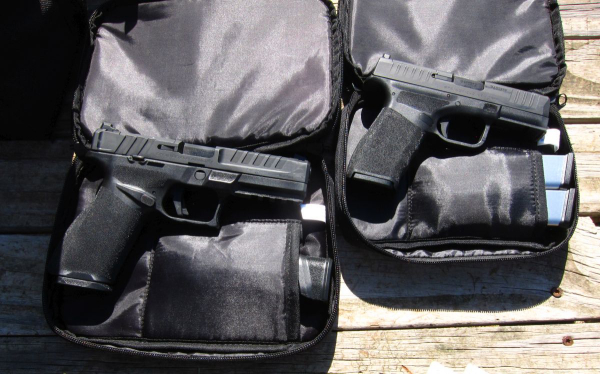
Is there a significant difference in handling and deployment competency between the moderate capacity-micro compact autos and their predecessor service- and service-compact autos? Ken Hackathorn has noted the difficulty many have in handling the “pocket rockets,” and Darryl Bolke noted that he has difficulty with the G43.
I imagine the difference varies based on fit not feel, handling the controls and juggling magazines of the smaller heaters compared to the larger guns. Hitting is a matter of holding the gun still as possible through the ignition sequence.
Getting the firing grip of the piece in the holster quickly is a problem not just of holster design but the size of the gun. If you have huge mitts, that puts you behind the 8-ball in terms of effective use of the smaller guns.
It also goes to your experience in handling small revolvers – the expectation of many is “the smaller the gun, the less the accuracy.” That’s not true. If you added “practical” to the “accuracy” component, you’d be closer.
I recently shot the G43X because I’d been carrying it because it needed maintenance and fresh ammo. That’s when the issue of comparing the smaller, very popular line of carry guns to the established standard came to my attention.
First, what test to use to compare the smaller guns? To start, five rounds on a B8 at 15 yards to ensure I was on as far as the visual solution. Then, posting a standardized target – I have the IALEFI-Q target -- I’d begin work at extreme distance for the ‘outlier’ event.
Moving in, work would include speed from the holster, high percentage shots from close to moderate distances. The end would feature hits from low ready as “the quickest draw is having the gun in your hand.”
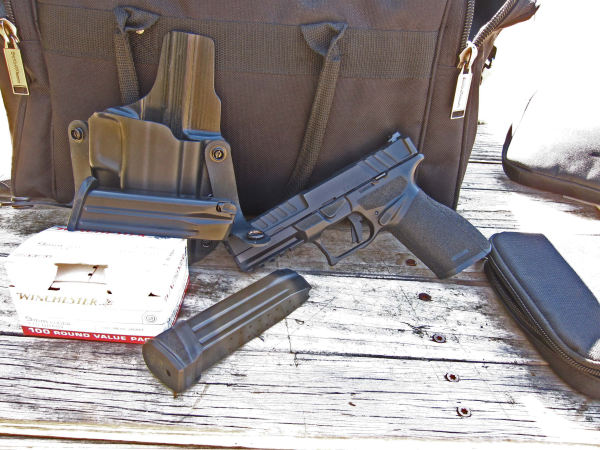
I settled on 20 rounds for this portion of the test.
Aside from the distance shooting, times and hits would be recorded for each string. At the end, there’d be a string-for-string comparison. The Sample size is small. There are only so many guns and I’d be reluctant to take a box of guns out and shoot this thing repetitively on the same trip; we’d quickly run afoul of “training effect” and soon wander into fatigue.
I’d just like to begin to quantify the differences in the envelope of the defense pistol as a bit of a baseline.
The short “Micro-compact Standards” use the IALEFI-Q target, scored as follows: center ring = 10 points, 2nd ring = 8 points, “bottle” = 2 points. That’s 200 points possible; recording times and hits for each string in the “par” stages.
50 yards | 5 singles | center
25 yards | single | “head”
5 yards | single, SHO | “head” 2.5 sec.
7 yards | single | “head” 2.5 sec.
7 yards | pair | center 2.0 sec.
7 yards | failure | 2.5 sec.
10 yards | pair center | 2.5 sec.
15 yards | pair center | 3.0 sec.
15 yards | single, guard | center 2.5 sec. (X3)
(20 rounds, 200 points possible, +5 rounds “sighters”)
The baseline was the Springfield Echelon in a Galco Corvus holster configured for IWB carry, shooting Winchester “White Box” 115gr. FMJ. The sighters were fired from fifteen yards. Four of five rounds went high, one hit the “X.” As usual, I tended to the right.
From 50 yards, there was a hit at 11:30, one at 4:30 and three off the right side at 3 o’clock. The single-head at 25 yards was high, off target at one o’clock. From five yards, the hit was in the head circle in 2.2 seconds. The single head hit from 7 yards came out at 1.96 in the circle. This was followed by a successful pair (over time) at seven and another in time at ten yards. At fifteen yards, there was a fair run. The score ended at 188/200.
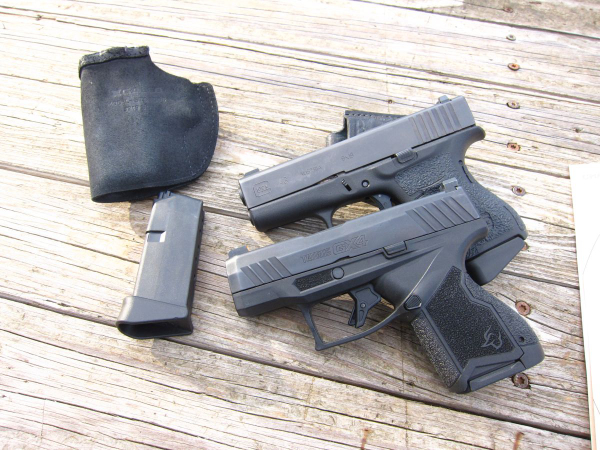
The Hellcat Pro was drawn from the Galco King Tuk Cloud IWB and fired with the same ammo over the same course. The fifteen-yard sighters all clustered inside the 10 ring. At fifty yards, the score was 34/50, with three in the “10” ring and two in the “bottle” outside the rings.
That’s fair shootin’.
At 25 yards, the high percentage shot veered right off the bottle for a -10. That, sadly, was the shooter. But we’re comparing the guns used by the same shooter.
At five yards, the two-second hit, one-handed, was just over two seconds, just like the succeeding seven-yard shot. The pair at seven yards was in time with one in the bottle, not the rings. The failure drill took up too much time, with dismal results. At ten yards, I lost eight points.
Likewise, at fifteen yards, I had bad hits and fair times. Just scoring the target without docking for times, I ended at 178/200.
Finally, the Galco Stow-N-Go holster was used with the Taurus GX4 and a GLOCK 43.
I loaded the GX4 with the 11-round magazines full to check function. The GX4 has XS Sights, G43 has Ameriglo Spaulding sights and Talon-Grip.
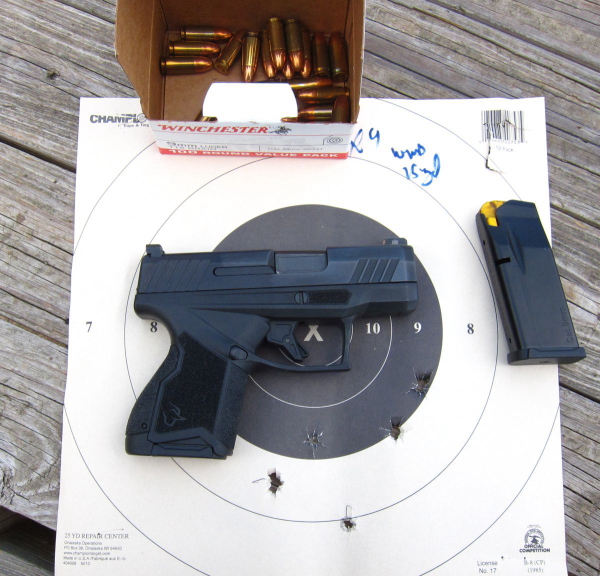
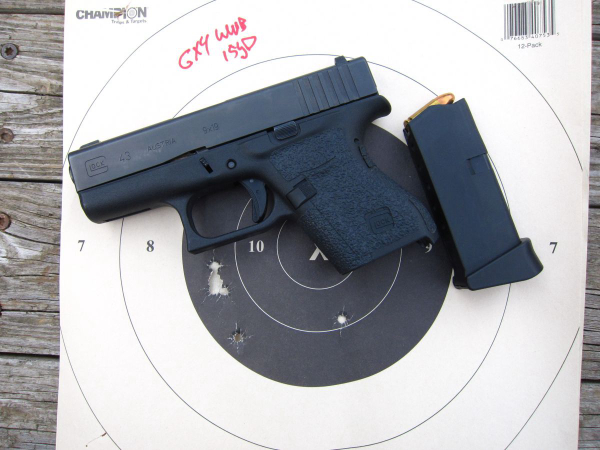
Without going through the details of each, the fifty-yard results were dismal. The GX4 hit below the headbox at 25 yards, still a hit. (The G43 put the 25-yard round into the circle.) The hits with the GX4 didn’t get a lot better and the times suffered. Ending score for the Taurus was a disappointing 92/200.
The GLOCK 43 did well with the fifteen-yard sighters. I found that, when I had time, I could do some decent work with it. The problem is time to handle such a small pistol. I found two things with these smaller guns: over time = “harder to shoot;” hits outside the center or off target = harder to shoot.
Suspicions confirmed.
The GLOCK 43 ended up with 138/200.

My micro-compact baseline was with an old favorite, the “Retail Shield.” A late specimen of the original S&W M&P Shield line, it’s an example of a gun type I’ve shot a lot. You can’t tell that from the score. The ammo was Fiocchi 9AP 115gr. FMJ.
The sighters on the B8 from fifteen yards yielded a 49/50, making me overestimate my skills. The distance shooting component was tragic, the closer exercises saw me lose points I shouldn’t have. From that point, it was on/off; some good enough, some stupidly off. The total was worse than the G43 (slightly) at 136/200.
The results? Rain is wet. Smaller guns are harder to shoot well, just like everyone said. The question – how much? – was not so well defined. I had an off-day with the Shield. That’s like actual battle any day. You can’t afford to lose rounds then.
— Rich Grassi